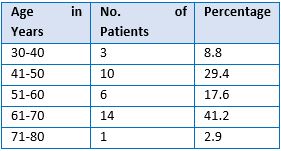Clinical study on the combined effectiveness of Mashasaptaka Kwatha and Marsha Nasya with Mashasaptaka Taila in Pakshaghata (cerebrovascular accident-infarct)
DOI:
https://doi.org/10.21760/jaims.7.6.8Keywords:
Pakshaghata , Cerebrovascular Accident, Mashasaptaka kwatha, Marsha nasyaAbstract
Background: Pakshaghata is one among Vataja Nanatmaja Vyadhis which are considered as Mahavyadhis. Pakshaghata can be correlated with Hemiplegia, the commonest pathology of which is cerebrovascular accident (stroke). Stroke is defined as sudden onset of neurologic deficit from vascular mechanism. 85% of all strokes are ischemic and 15% are hemorrhagic. Aims And Objectives: To evaluate the combined effectiveness of Mashasaptaka Kwatha and Marsha Nasya with Mashasaptaka Taila in the management of Pakshaghata (Cerebrovascular Accident-infarct). Methods: Thirty diagnosed subjects of Pakshaghata (CVA due to infarct) were administered with Mashasaptaka Kwatha and Marsha Nasya with Mashasaptaka Taila for 7 days. The data of patients was recorded before and after treatment using an elaborate proforma. Assessment was done based on the primary and secondary outcome measures. For statistical analysis, Wilcoxon Signed Rank test, McNemar tests were used. Results: In this study it was found that there was statistically significant relief in the symptoms of Pakshaghata (Cerbrovascular accident-infarct). Conclusion: Relief in the symptoms was achieved by the drugs having properties such as Vatakaphahara, Anulomana, Brimhana, Srotoshodhana etc. Hence, Mashasaptaka Kwatha and Marsha Nasya with Mashasaptaka Taila for 7 days is effective in the management of Pakshaghata (Cerebrovascular accident-infarct).
Downloads
References
Acharya Y T. Sushruta Samhita with Nibandhasangraha commentary of Dalhanacharya. Sutra Sthana 33/3. Reprint ed. Varanasi (India): Chaukambha Sanskrit Sansthan; 2014. p. 144.
Acharya YT. Charaka Samhita with Ayurveda Dipika commentary of Chakrapani Datta. Sutra Sthana 20/11. Reprint ed. Varanasi (India): Chaukambha Orientalia; 2014.p.113
Acharya YT. Charaka Samhita with Ayurveda Dipika commentary of Chakrapani Datta. Chikitsa Sthana 28/43. Reprint ed. Varanasi (India): Chaukambha Orientalia; 2014.p.619
Acharya YT. Charaka Samhita with Ayurveda Dipika commentary of Chakrapani Datta. Chikitsa Sthana 28/44. Reprint ed. Varanasi (India): Chaukambha Orientalia; 2014.p.619
Acharya Madhavakara, Madhava nidanam with madhukosha Sanskrit commentary by Acharya Vijaya Rakshit and Shrikanta Datt,Edited by Dr.Ravidatt Tripady,1st Volume 22th chapter,1st Edition – 1993 published by Varanaseya Sanskrit Sansthan, Page no.505
John maclod edited Devid sons principles and practice of medecine edited 2003, pub: pitman press, Great Britain. pp432 th
Warlow CP, Dennis MS, VanGinj J et al : A practical approach to management of stroke patients. In : Stroke: a practical guide to management. Blackwell sciences, London. 1996; 360-384
Kasper, Dennis L.,, et al. Harrison’s Principles of Internal Medicine. 2nd volume 17th chapter, 19th edition. New York: McGraw Hill Education, 2015. P.3068
Prasad K, Vibha D, Meenakshi Cerebrovascular disease in South Asia - Part I: A burning problem. JRSM Cardiovasc Dis. 2012; 1:20.
Prasad K: Epidemology of cerebrovascular disorders in India. In: Recent concepts in stroke by Bansal BC (ed) Indian college of Physicians, New Delhi. 1994;p4-192
Colledge Nick R, Walker BrainR, Ralston StuartH. Devidson, Principle and practice of medicine. Reprint 2010, pub:pitman press, Great Britain. P.1184
StrokefactsheetIndia.Accessed21july2013;http://www.sancd.org/Updated%20Stro ke%20Fact%20sheet%202012.pdf)
Kasper, Dennis L., et al. Harrison’s Principles of Internal Medicine. 2nd volume 17th chapter, 19th edition. New York: McGraw Hill Education, 2015. P.2560
Acharya YT. Charaka Samhita with Ayurveda Dipika commentary of Chakrapani Datta. Chikitsa Sthana 28/100. Reprint ed. Varanasi (India): Chaukambha Orientalia; 2014.p.621.
Acharya Y T. Sushruta Samhita with Nibandhasangraha commentary of Dalhanacharya. Chikitsa Sthana 5/19. Reprint ed. Varanasi (India): Chaukambha Sanskrit Sansthan; 2014. p. 427-428
Tripathi, Jagadishwar prasad, Chakradutta of Tripathi Jagadishwar prasad, Vatavyadhi chikitsa:22,23, chaukhamba Sanskrit series office, Varanasi,1986,185
A. Raghavan: Z. A. Shah; Springer Science+Business Media New York 2014; Withania somnifera Improves Ischemic Stroke Outcomes by Attenuating PARP1-AIFMediated Caspase-Independent Apoptosis















